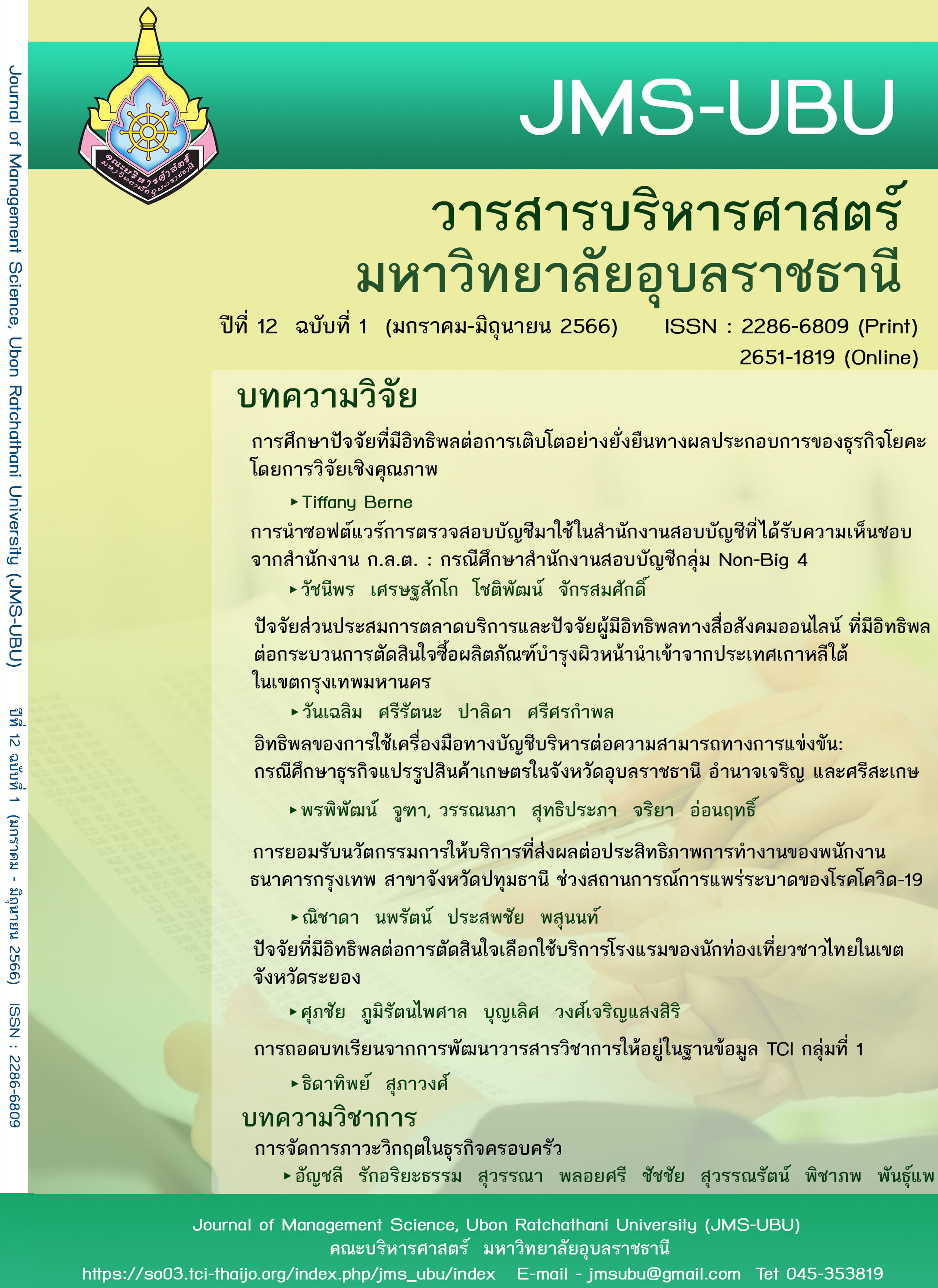การนำซอฟต์แวร์การตรวจสอบบัญชีมาใช้ในสำนักงานสอบบัญชีที่ได้รับความเห็นชอบจากสำนักงาน ก.ล.ต. : กรณีศึกษาสำนักงานสอบบัญชีกลุ่ม Non-Big 4
Main Article Content
บทคัดย่อ
งานวิจัยนี้เป็นงานวิจัยเชิงคุณภาพ มีวัตถุประสงค์เพื่อค้นหาซอฟต์แวร์การตรวจสอบบัญชี ประโยชน์และอุปสรรคของการนำซอฟต์แวร์การตรวจสอบบัญชีมาใช้ในสำนักงานสอบบัญชีที่ได้รับความเห็นชอบจากสำนักงานคณะกรรมการกำกับหลักทรัพย์และตลาดหลักทรัพย์แห่งประเทศไทยโดยใช้สำนักงานสอบบัญชีกลุ่ม Non-Big 4 จำนวน 5 แห่งเป็นกรณีศึกษา วิธีวิจัยใช้วิธีสัมภาษณ์เชิงลึกกึ่งมีโครงสร้างกับผู้บริหารระดับสูง สำนักงานสอบบัญชีกลุ่ม Non-big4ทั้ง 5 แห่ง มีความแตกต่างในด้าน (1) ทุนจดทะเบียน (2) จำนวนปีที่ดำเนินงาน (3) รายได้รวม (4) จำนวนบริษัทจดทะเบียนที่ให้บริการ (5) จำนวนผู้สอบบัญชีที่ได้รับความเห็นชอบจากสำนักงานก.ล.ต. (6) จำนวนพนักงานทั้งสิ้น และ (7) การเป็นสมาชิกของสำนักงานสอบบัญชีชั้นนำระดับโลก
ผลการวิจัยพบว่าสำนักงานสอบบัญชีกลุ่ม Non-Big 4 ทั้ง 5 แห่ง ใช้ Microsoft Excel และ Microsoft Word เป็นซอฟต์แวร์พื้นฐานในการตรวจสอบบัญชี ส่วน Voyager, Audit Command Language, CCH® Audit Automation, IDEA® Data Analysis Software, และ Monetary Unit Sampling เป็นซอฟต์แวร์ที่สำนักงานสอบบัญชีบางแห่งได้นำมาใช้งานเพิ่มเติมจากซอฟต์แวร์พื้นฐานเท่านั้น การนำซอฟต์แวร์การตรวจสอบบัญชีมาใช้ในการสอบบัญชีทำให้ผู้สอบบัญชีสามารถ (1) ลดระยะเวลาปฏิบัติงาน และ (2) ตรวจสอบได้ครบถ้วน และลดอคติในการตรวจสอบ สำหรับอุปสรรคของการนำซอฟต์แวร์การตรวจสอบบัญชีมาใช้คือ (1) ต้นทุนของการจ่ายลงทุนที่มีมูลค่าสูง และ (2) ขาดความรู้ทางเทคโนโลยีและความเชี่ยวชาญด้านภาษาอังกฤษ
Downloads
Article Details

This work is licensed under a Creative Commons Attribution-NonCommercial-NoDerivatives 4.0 International License.
References
สำนักงานคณะกรรมการกำกับหลักทรัพย์และตลาดหลักทรัพย์. (2563). รายชื่อผู้สอบบัญชีที่ได้รับความเห็นชอบ. สืบค้นเมื่อ 14 กุมภาพันธ์ 2563, จาก https://market.sec.or.th/public/orap/AUDITOR01.aspx?lang=th
Akpanuko, E. E., & Umoren, N. J. (2018). The influence of creative accounting on the creditability of accounting reports. Journal of Financial Reporting and Accounting, 16(2), 292-310.
Alles, M. G. (2015). Drivers of the use and facilitators and obstacles of the evolution of big data by the audit profession. Accounting Horizons, 29(2), 439-449.
Alles, M., & Gray, G. L. (2016). Incorporating big data in audits: Identifying inhibitors and a research agenda to address those inhibitors. International Journal of Accounting Information Systems, 22, 44-59.
BDO Advisory Limited. (2019). Transparency report 2019. Retrieved February 9, 2020, from https://www.bdo.com.mt/en-gb/about/transparency-reports/transparency-report-2019
Braun, R. L., & Davis H. E. (2003). Computer-assisted audit tools and techniques: Analysis and perspectives. Managerial Auditing Journal, 18(9), 725-731.
Cao, M., Chychyla, R., & Stewart, T. (2015). Big data analytics in financial statement audits. Accounting Horizons, 29(2), 423-429.
Cho, S., Vasarhelyi, M. A., & Zhang, C. (2019). The forthcoming data ecosystem for business measurement and assurance. Journal of Emerging Technologies in Accounting, 16(2), 1-21.
Cohen, M., Rozario, M. A., & Zhang, C. (2019). Exploring the use of robotic process automation (RPA) in substantive audit procedure. The CPA Journal, 89(7), 49-53.
Crowe. (2016). Crowe Horwath advances its audit practice with new, integrated technology. Retrieved February 9, 2019, from https://www.Crowe.com/news/Crowe-insight-center-for-audit
Curtis, M. B., & Payne, E. A. (2008). An examination of contextual factors and individual characteristics affecting technology implementation decisions in auditing. International Journal of Accounting Information Systems, 9(2), 104-121.
Dagiliene, L., & Kloviene, L. (2019). Motivation to use big data and big data analytics in external auditing. Managerial Auditing Journal, 34(7), 750-782.
Deloitte (2018). 2018 Audit quality report - Our priority, today and always. Retrieved February 5, 2019, from https://www2.deloitte.com/content/dam/Deloitte/ca/Documents/audit/ca-en-2018-audit-quality- report.pdf
Deloitte Touche Tohmatsu Limited. (2018). For internal audit, big data represents a big opportunity. Retrieved February 5, 2020, from: https://deloitte.wsj.com/cio/2018/02/06/for-internal-audit-big-data-represents-a-big-opportunity/
Denzin, N., & Lincoln, Y. S. (1998). The Landscape of Qualitative Research. Thousand Oaks, CA: Sage Publishing.
Ernst & Young LLP. (2019). Our Commitment to Audit Quality. Retrieved January 22, 2020, from https://assets.ey.com/content/dam/ey-sites/ey-com/en_us/topics/assurance/2019-commitment-to-audit-quality-report/our-commitment-to-audit-quality_brochure.pdf
Gartner. (2012). Gartner says big data will drive $28 billion of IT spending in 2012. Retrieved January 22, 2019, from: https://www.businesswire.com/news/home/20121017005374/en/Gartner-Says-Big-Data- Will-Drive-28-Billion-of-IT-Spending-in-2012
Grant Thornton International Ltd. (2020). Global audit technology. Retrieved March 12, 2021, from https://www.grantthornton.global/en/service/Assurance/global-audit-technology/
Han, S., Rezace, Z., Xue, L., & Zhang, J. H. (2016). The association between information technology investments and audit risk. Journal of Information Systems, 30(1), 93-116.
Janvrin, D., Bierstakers, J. L., & Lowe, D. J. (2008). An examination of audit information technology use and perceived importance. Accounting Horizons, 22(1), 1-21.
Kend, M., & Nguyen, L. A. (2020). Big data analytics and other emerging technologies: The Impact on the Australian audit and assurance profession. Australian Accounting Review, 90, 1-14.
KPMG. (2018). Next Generation Audit. Retrieved December 15, 2019, from https://assets.kpmg/content/dam/kpmg/us/pdf/2018/10/kpmg-audit-forbes-nga-report.pdf
Krieger, F., Drews, P., & Velte, P. (2021). Explaining the (non-) adoption of advanced data analytics in auditing: A process theory. International Journal of Accounting Information Systems, 41, DOI: 10.1016/j.accinf.2021.100511
Lombardi, D. R., Bloch, R., & Vasarhelyi, M. A. (2015). The current state and future of the audit profession. Current Issues in Auditing, 9(1), 10-16.
Lowe, D. J., Bierstaker, J. L., Janvrin, D. J., & Jenkins, G. (2018). Information technology in an audit context: Have the big 4 lost their advantage? Journal of Information Systems, 32(1), 87-107.
Miles, M. B., & Huberman, A. M. (1994). Qualitative Data Analysis. An Expanded Sourcebook (2nded.). Thousand Oaks, CA: Sage Publication.
Moffitt, K. C., Rozario A. M., & Vasarhelyi, M. A. (2018). Robotic process automation for auditing. Journal of Emerging Technologies in Accounting, 15(1), 1-10.
Nearon, B. H. (2005). Foundations in auditing and digital evidence. The CPA Journal, 75(1), 32-34.
Otete, A. R. (2020). Adoption of audit software by small and medium-sized practices in east Africa. European Journal of Accounting, Auditing and Finance Research, 8(9), 25-40.
Pricewaterhouse Coopers ABAS Ltd. (2017). Annual report 2016/2017. Retrieved December 15, 2019, from https://www.pwc.nl/nl/assets/documents/pwc-annual-report-2016-2017.pdf
Razi, M. A., & Madani, H.H. (2013). An analysis of attributes that impact adoption of audit software: An empirical study in Saudi Arabia. International Journal of Accounting and Information Management, 21(2), 170-188.
Rezaee, Z., Sharbatoghlie, A., Elam, R., & Mcmickle, P. L. (2002). Continuous auditing: Building automated
auditing capability. Auditing: A Journal of Practice and Theory, 21(1), 147-163.
RSM US LLP. (2022). RSM US LLP audit quality report. Retrieved June 11, 2022, from https://rsmus.com/content/dam/rsm/services/audit/1pdf/commitment-to-audit-quality.pdf.coredownload.inline.png
Tang, J. J., & Karim, K. E. (2017). Big data in business analytics: Implications for the audit profession. The CPA Journal (1975), 87(6), 34-39.
Vasarhelyi, M. A., & Romero, S. (2014). Technology in audit engagements: A case study. Managerial Auditing Journal, 29(4), 350-365.
Wells, J. T. (2001). And nothing but the truth: Uncovering fraudulent disclosures. Journal of Accountancy, 192(1), 47-52.
Widuri, R., O’Connell, B., & Yapa, P. W. S. (2016). Adopting generalized audit software: An Indonesian perspective. Managerial Auditing Journal, 31(8/9), 821-847.
Yin, R. K. (2003). Case Study Research: Design and Method (3rd ed.). London: Sage.
Zhang, C. (2019). Intelligent process automation in audit. Journal of Emerging Technologies in Accounting, 16(2), 69-88.
